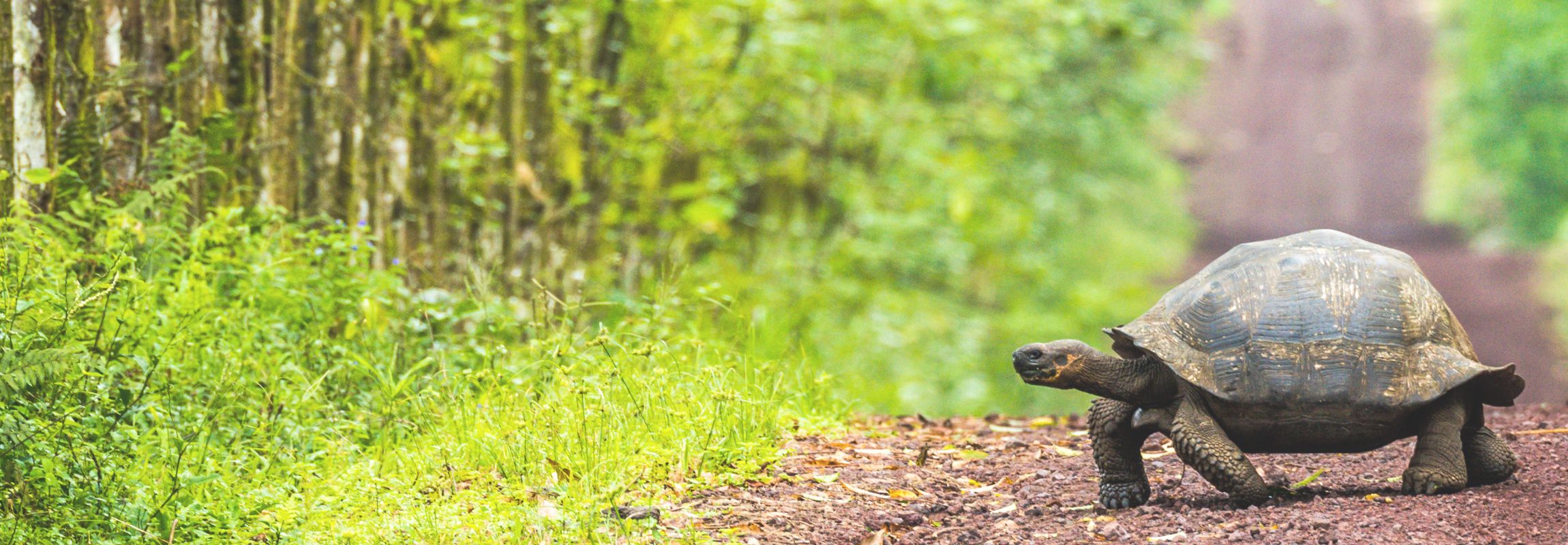
Santa Cruz Island Guide – What to Do in Santa Cruz Island on Your Own
This complete Santa Cruz Island Guide contains the most relevant natural and cultural sites as well as the best spots to grab a bite, to make sure you don’t miss a thing while visiting the island on your own. Whether you stop here before or after boarding a Galapagos cruise, if you are visiting through an Island Hopping program, or if you are exploring Galapagos on your own terms, this guide will help you make the most of your time in the main port of the Galapagos Islands. So without further ado…
Start your adventure in Santa Cruz
Welcome to Santa Cruz Island, the beating heart of the Galapagos Archipelago. This vibrant hub pulsates with life, drawing you into its captivating embrace. As you set foot on this bustling island, you’ll find yourself in the enchanting port town of Puerto Ayora, a place brimming with charm and vitality. Immerse yourself in its spirited ambiance, where you can explore a multitude of captivating boutiques and indulge in delectable dining establishments that offer breathtaking views of the expansive ocean. The town comes alive day and night, with a vibrant social scene that invites you to join in the festivities.
Beyond the town’s lively rhythm lies a world of natural wonders waiting to be discovered. Picture yourself on windswept beaches, feeling the gentle caress of ocean breezes, or exploring lush reserves where majestic giant tortoises roam freely, a testament to the island’s rich biodiversity. Marvel at awe-inspiring volcanic craters that stand as reminders of the island’s tumultuous past. And for moments of pure serenity, uncover secluded swimming holes with crystal-clear turquoise waters that beckon you to take a refreshing dive. Whether you choose a land-based Galapagos exploration or a captivating cruise adventure, Santa Cruz Island offers an array of experiences that cater to every soul who seeks adventure and wonder. Get ready to be captivated by this essential destination, for it promises an unforgettable experience for all who venture here.
To ensure you make the most of your time in Santa Cruz and Puerto Ayora, be sure to keep on reading our Santa Cruz Island Guide. This invaluable resource will provide you with insider tips, hidden gems, and detailed maps to navigate the island with ease. From must-visit attractions to off-the-beaten-path treasures, our guide is your trusted companion in unlocking the secrets of Santa Cruz Island.
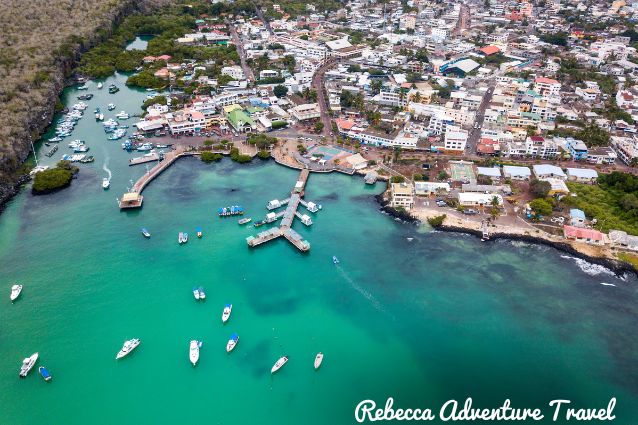
Aerial View of Puerto Ayora.
Santa Cruz Island Most Important Information at a Glance
- Population: Santa Cruz Island has a population of approximately 12,000 residents. It is one of the most populated islands in the Galapagos archipelago.
- Size: The island covers an area of around 986 square kilometers (380 square miles). Which makes it the second-largest island in the Galapagos.
- Location: Santa Cruz Island is located in the central part of the Galapagos archipelago, situated between Isabela Island to the west and Baltra Island to the north.
- Main Town: The main town on Santa Cruz Island is Puerto Ayora. It serves as the economic and tourism hub of the Galapagos. It is the largest town in the archipelago and offers various services, accommodations, and attractions for visitors.
- Economic Activities: The main economic activities on Santa Cruz Island revolve around tourism, fishing, agriculture, and services. Tourism plays a significant role, as the island attracts a large number of visitors who come to explore the iconic wildlife and natural wonders of the Galapagos.
- Conservation Efforts: Santa Cruz Island is home to the Charles Darwin Research Station, which focuses on scientific research, conservation, and environmental education. The research station plays a vital role in preserving the fragile ecosystem of the Galapagos Islands.
- Wildlife: The island is known for its diverse wildlife, including the iconic Galapagos giant tortoises, marine iguanas, sea lions, blue-footed boobies, and many other species. Visitors have the opportunity to observe and interact with these remarkable animals in their natural habitats.
- Natural Sites: Santa Cruz Island boasts several natural attractions, such as Los Gemelos (the twin volcanic sinkholes), Tortuga Bay (a stunning white-sand beach), and the highlands with their lush vegetation and lava tunnels. These sites offer visitors the chance to explore the island’s unique geological features and natural beauty.
- Transportation: Santa Cruz Island is well-connected to other islands in the Galapagos archipelago. It has an airport on Baltra Island, and ferries provide transportation between Santa Cruz and neighboring islands.
Santa Cruz Island Geological History
The Island in the Galapagos archipelago holds a captivating geological history that has shaped its unique landscape. This volcanic island emerged from the depths of the Pacific Ocean through a series of volcanic eruptions millions of years ago. Its origins can be traced back to the formation of a hotspot, a plume of molten rock rising from deep within the Earth’s mantle. Over time, repeated volcanic activity and the movement of tectonic plates molded the island’s terrain, resulting in rugged coastlines, dramatic cliffs, and towering volcanic cones. The geological forces gave birth to fascinating features like Los Gemelos, twin volcanic sinkholes. Which were created by collapsed magma chambers, offering a glimpse into the island’s volcanic past. As you explore Santa Cruz Island, you’ll be immersed in its geological tapestry. It truly is a testament to the ever-evolving forces of nature that have shaped this extraordinary corner of the Galapagos.
Things To Do in Santa Cruz Island – Sites Guide
During your captivating journey on Santa Cruz Island in the Galapagos archipelago, there are several self-guided activities you can embark on. Let Rebecca Adventure Travel provide you with important information about the must-see places and how to reach them.
NOTE: Refer to the map at the end of the Santa Cruz Island Guide to locate all the sites.
Charles Darwin Research Station
Begin your exploration by visiting the Charles Darwin Research Station, a pioneering institution in the Galapagos. This renowned research station is a must-visit destination. Here, you will encounter incredible tortoises ranging from just 3 inches to 4 feet in length. These majestic creatures are known for their interactive behavior, often engaging with both fellow tortoises and humans alike. Be prepared for a unique experience as some of these tortoises may even extend their heads for a gentle petting. The research station also offers insights into the captivating story of Lonesome George, the last of his tortoise species who unfortunately passed away in June 2012. However, you’ll have the opportunity to see the most famous tortoise in the world and learn about his life and species from knowledgeable guides.
To reach the Charles Darwin Research Station, you can take a taxi for a quick 5-minute ride. Alternatively, if you prefer to walk, it will take approximately 15 minutes from your hotel. Follow the path to the left of the hotel area, continue straight until you reach the first intersection, then turn left onto ¨Calle No. 63¨. Keep walking until the road ends and take a left, continuing straight until you arrive at the Charles Darwin Research Station.
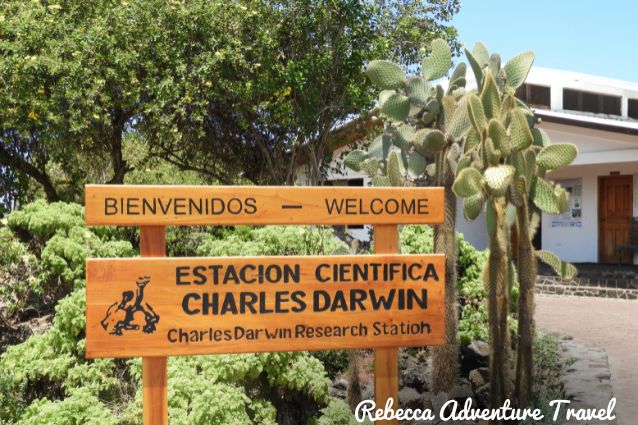
Charles Darwin Research Station.
Los Gemelos
As you explore Santa Cruz Island, make sure to visit Los Gemelos, twin volcanic sinkholes that offer a fascinating glimpse into the island’s geological history. To reach Los Gemelos, you can take a taxi from Puerto Ayora, which will take around 25 minutes. Alternatively, you can arrange for a guided tour or hike from the town, following the designated trails that lead to these impressive formations. You can also visit this striking location on your way to or from the Baltra Airport, as it is conveniently situated next to the only highway connecting Puerto Ayora to the ferry terminal for Baltra Airport.
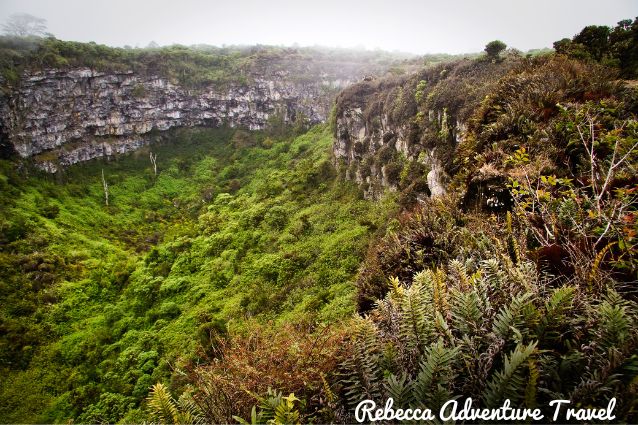
Los Gemelos in sinkhole in Santa Cruz.
Playa de la Estación
From the Charles Darwin Research Station, a short one-minute walk will lead you to Playa de la Estación, a beautiful beach perfect for snorkeling. Immerse yourself in the crystal-clear waters while enjoying panoramic views of Academy Bay.
Las Grietas
Located approximately 600 meters beyond Playa de los Alemanes, you’ll discover Las Grietas, a mesmerizing crack between rocks with breathtakingly clear blue waters. The leisurely 15-minute walk to Las Grietas will reward you with opportunities for cliff jumping and snorkeling. You can dive into the water from a wooden dock or even the sides of the rocks. The clarity of the water also makes it an ideal spot for snorkeling. For a unique experience, swim through a one-meter tunnel to reach the other end of the clear waters. The path to Las Grietas offers a scenic hike through the distinctive setting of Santa Cruz Island. If you continue walking to a higher point, you’ll be treated to a magnificent view of the bay and the harbor of Puerto Ayora.
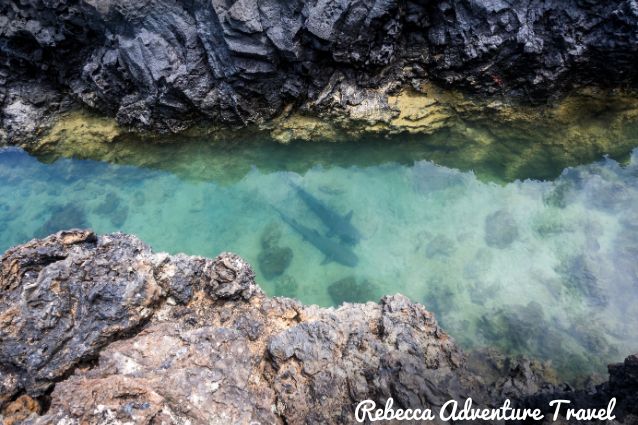
Las Grietas.
Las Ninfas
Just a short 5-minute walk from the center of Puerto Ayora lies Laguna Las Ninfas. Head west from the harbor and take the first left. After approximately 100 meters, turn left again, and you’ll find yourself at the lagoon. This peaceful sanctuary features a boardwalk path where you can observe mangroves, baby sharks, sea turtles, stingrays, and an array of other fascinating animals. Keep an eye out for the diverse bird species that also call this area home.
Tortuga Bay
Indulge in the beauty of Tortuga Bay, a picturesque white sandy beach that embodies the essence of paradise. Its pristine shores, turquoise waters, and surrounding mangroves make it one of the most breathtaking spots in the Galapagos Islands. The path leading to Tortuga Bay is popular among locals for running or biking. You have two options to reach the beach: a leisurely 2.8 km walk that takes approximately an hour or a boat ride departing from the harbor of Puerto Ayora. Boat tickets can be purchased at a stand in the Puerto Ayora harbor. Keep in mind that if you choose the boat option, you’ll have a set amount of time before the boat returns to the harbor.
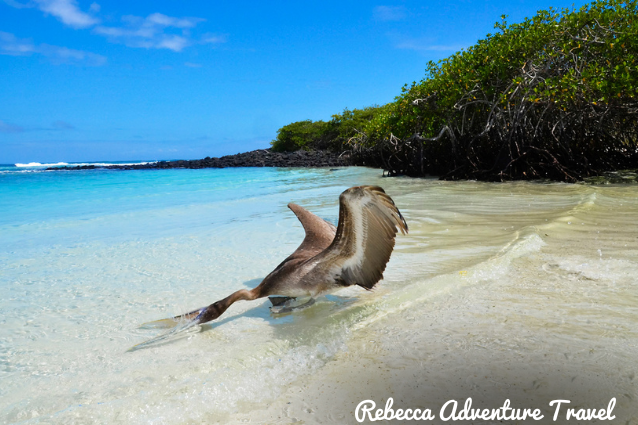
Tortuga Bay.
Fishermen’s Wharf
Located in the Pelican Bay neighborhood on Charles Darwin Avenue, Fishermen’s Wharf is a bustling pier on Santa Cruz Island. It offers a glimpse into the world of artisanal fishing and showcases the abundant marine life in the area. Sea lions, pelicans, herons, frigate birds, and seagulls can be observed here, creating a lively atmosphere. Tourists flock to this site year-round to witness the captivating spectacle of animals eagerly awaiting their share of the fishermen’s catch. Indulge in delicious seafood while appreciating the hard work of the local fishermen. Don’t miss this unique experience during your visit to Santa Cruz Island.
Las Bachas Beach
With its crystal clear waters, white sandy shores, and tranquil seas, Las Bachas Beach is a true paradise on Santa Cruz Island. It stretches approximately 1 kilometer along the northern coast and offers excellent snorkeling opportunities. This beach holds great significance as one of the primary nesting sites for sea turtles on the island. Alongside these majestic creatures, you can spot flamingos, waterfowl, migratory birds, and the iconic iguanas that grace the Galapagos. When planning your itinerary, be sure to include a visit to Las Bachas Beach. Keep in mind that the beach does not have tourist facilities, so remember to bring your own provisions.
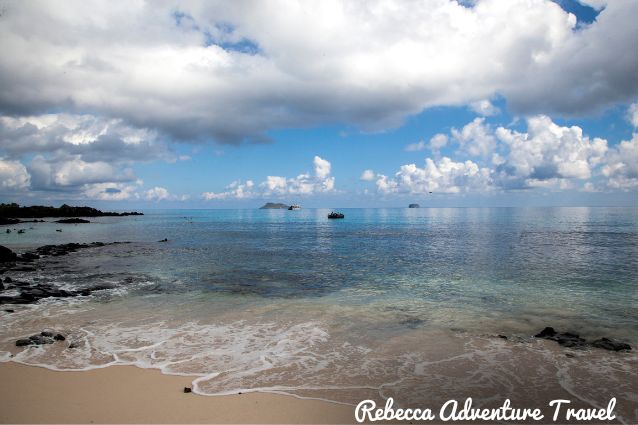
Las Bachas Beach.
El Garrapatero Beach
Escape to the tranquility of El Garrapatero Beach on Santa Cruz Island’s eastern coast. Located northeast of Puerto Ayora, this pristine beach is a hidden gem worth discovering. It’s accessible independently or with a tour guide, El Garrapatero offers opportunities for snorkeling, kayaking, and camping. Note that proper authorization from the Galapagos National Park is required. To reach the beach, you can take a taxi from Puerto Ayora to the trailhead, followed by a 15-minute walk through a scenic route featuring candelabra cacti, palo santo trees, and more. Alternatively, a water taxi ride of approximately 20 minutes from the port directly transports you to the beach. As you bask in the untouched beauty of El Garrapatero, keep an eye out for ghost crabs, seabirds, flamingos, and iguanas. Remember to bring your own supplies, as this unspoiled natural area lacks tourist facilities.
Rancho Primicias
For an unforgettable encounter with giant tortoises in their natural habitat, visit Rancho Primicias. It is a private ranch owned by the Devine family. Here, dozens of these magnificent creatures freely roam the grassy landscapes. Spotting the tortoises is an easy task as they amble around the ranch. Galapagos giant tortoises can reach impressive weights of up to 230 kilograms (500 pounds). Inside the ranch, a small café offers hot and cold drinks for your refreshment. Located in the highlands of Santa Cruz, Rancho Primicias is approximately 20 kilometers from Puerto Ayora. It is best to take a taxi, which will transport you to the ranch in about 30 minutes.
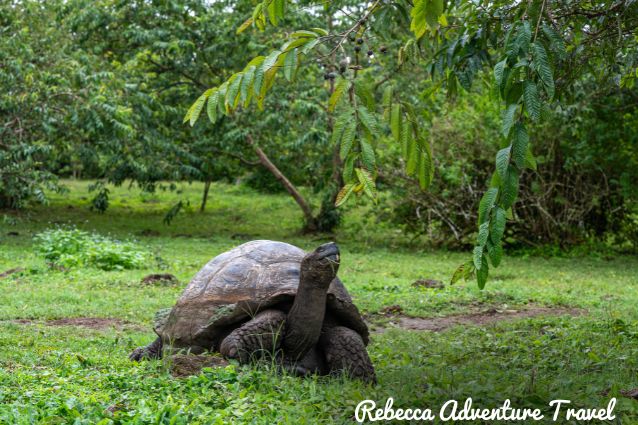
Galapagos giant tortoises.
As you venture through Santa Cruz Island’s natural wonders you’ll witness the extraordinary beauty and rich biodiversity that make the Galapagos archipelago a true haven for nature enthusiasts.
Where to Eat in Santa Cruz Island – Restaurant Guide
During your trip to Santa Cruz, make sure to take the opportunity to explore the island on your own. In Puerto Ayora, a delightful culinary adventure awaits as you embark on a journey to discover the local flavors and indulge in the exquisite Galapagos cuisine. Fortunately, Rebecca Adventure Travel has conducted extensive research to provide you with a carefully curated list of the best restaurants in town. Whether you are seeking a memorable night out with friends, an intimate spot for lunch, a legendary fix of junk food, or a tantalizing treat for your taste buds, we’ve got you covered. With a variety of options available, you can choose the perfect dining experience to suit your preferences.
NOTE: To easily locate these recommended restaurants, please refer to the map provided at the end of the Santa Cruz Island Guide.
La Garrapata
One of the standout options is La Garrapata. This charming restaurant offers a delightful fusion of Ecuadorian and international dishes that will surely satisfy your palate. Indulge in their highly recommended specialties, including the aromatic chicken curry, the delectable grilled seafood platter, or the succulent fish in coconut sauce. As the evening sets in, La Garrapata attracts a lively crowd, creating a welcoming atmosphere filled with cozy ambiance and captivating music.
Isla Grill
Indulge in mouthwatering grilled meats and seafood at Isla Grill. From tender pork ribs to char-grilled shrimp, octopus, and calamari, every bite is a culinary delight. Don’t forget to explore their refreshing salads, crafted to complement the grilled flavors.
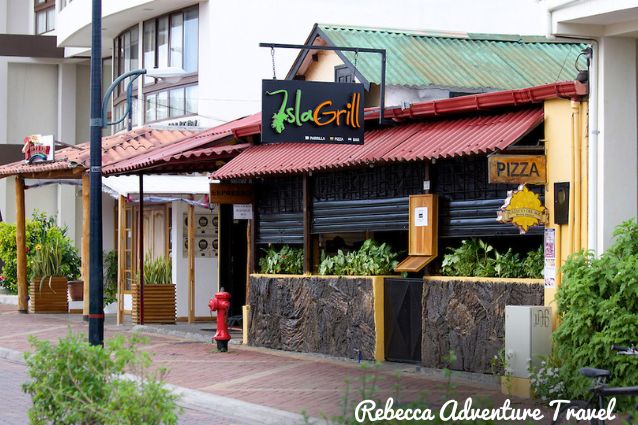
Isla Grill restaurant.
Il Giardino
Immerse yourself in the open-air ambiance of Il Giardino, an Italian trattoria with a charming patio. This culinary gem offers a range of delectable options, including succulent steaks, seafood platters, and irresistible desserts. Be sure to visit their attached Italian ice cream shop for a sweet finale to your meal.
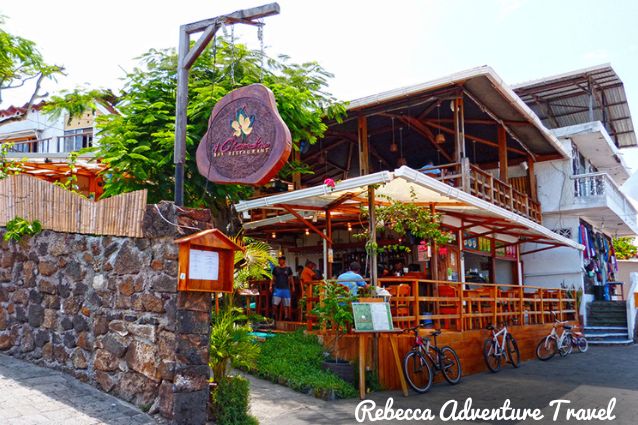
Il Giardino restaurant in Santa Cruz.
LO & LO Restaurant
Experience the authentic taste of Ecuadorian cuisine at the cozy LO & LO restaurant. This small, open-sided eatery serves up traditional plates like ceviche, goat stew, grilled fish, plantain balls (bolones), and empanadas. Delight in the flavors and immerse yourself in the local dining culture.
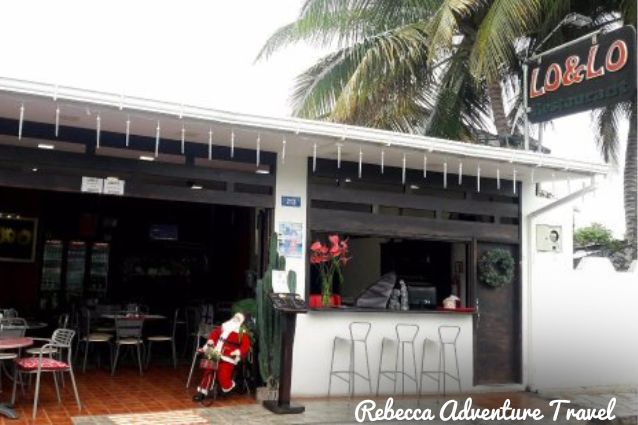
Lo & Lo restaurant.
Finch Bay Restaurant
For an exquisite and upscale dining experience, visit the restaurant at the luxurious Finch Bay Hotel. This culinary haven offers international and Galapagos-inspired dishes prepared by a Cordon Bleu-qualified chef. The chef’s commitment to using fresh ingredients, including homegrown vegetables, ensures a memorable dining experience. The fastest way to get to this restaurant is undoubtedly by water taxi since it is located on the other side of the bay. From there, it takes around 8 to 10 minutes on foot.
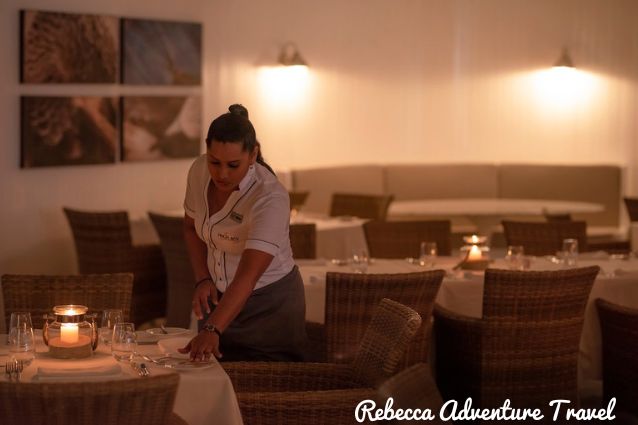
Finch Bay Restaurant in Santa Cruz.
Angermayer Waterfront Inn
Nestled on the other side of Academy Bay in Puerto Ayora, the Angermayer Waterfront Inn is a unique first-class hotel. Its restaurant boasts a picturesque setting on the deck. This provides the perfect vantage point to enjoy breathtaking views of the harbor. Additionally, you can indulge in fine lunches and immerse yourself in the tranquil ambiance that accompanies the dining experience.
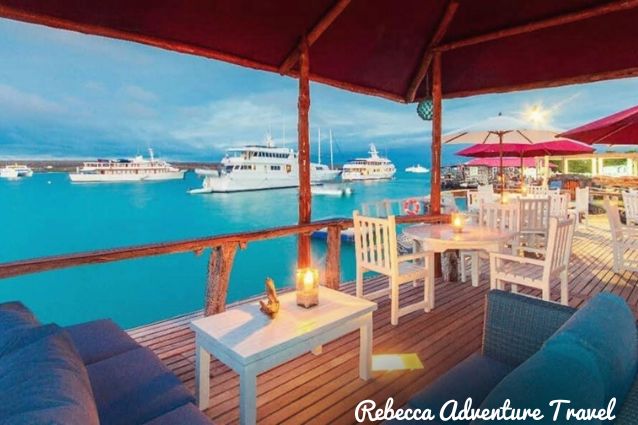
Angermeyer Waterfront Inn.
Los Kioskos
For a taste of local life, head to Los Kioskos, a typical gathering place where locals dine together at long tavern-style tables. While savoring the communal atmosphere, it is important to exercise caution when sampling the food. The quality may vary, particularly when it comes to raw or undercooked meat or seafood.
Embark on a culinary journey through the vibrant flavors of Santa Cruz Island, and savor the diverse offerings from local and international cuisines. Each restaurant has its own unique charm and culinary delights. This ensures that your dining experiences in Puerto Ayora will be unforgettable.
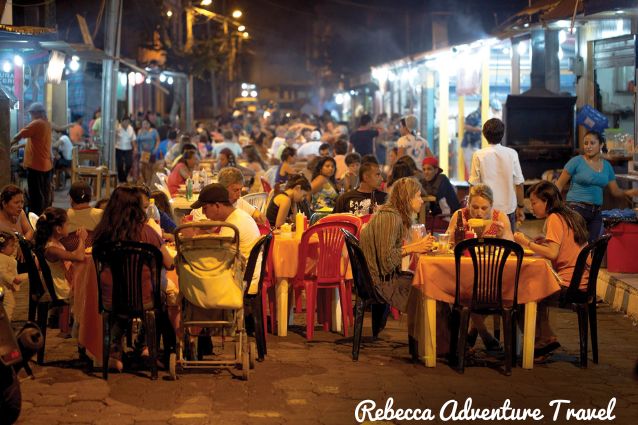
Los Kioskos.
Puerto Ayora and Santa Cruz Island Guide Map – Sites and Restaurants
Contact Numbers
If you have any questions, please do not hesitate to contact us:
- 24/7 General & Sales Enquiries Phone: +593-(0)980051675
- Office in Quito: +593-(0)2-6007590
On behalf of the entire Rebecca Adventure Travel Team, we wish you a joyous and unforgettable time on Santa Cruz Island! May your experience be filled with happiness and the beauty of this remarkable destination.




